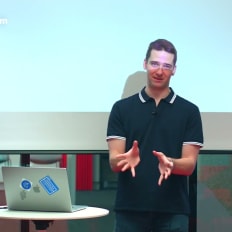
UNIQA Insurance Group AG
Eva-Maria Tscherne, Business Analyst bei UNIQA
Description
Eva-Maria Tscherne von UNIQA spricht im Interview über ihren Background wie sie zur Business Analyse gekommen ist und was ihre aktuelle Rolle beinhaltet und gibt Tipps zur Weiterentwicklung.
By playing the video, you agree to data transfer to YouTube and acknowledge the privacy policy.
Video Summary
In “Eva-Maria Tscherne, Business Analyst bei UNIQA,” Eva-Maria Tscherne recounts her non-linear path into business analysis, moving from a business-focused school to journalism, then economics, working at a bank, and entering a trainee program that led to BA/requirements engineering. She defines the BA role as a bridge between business and development—understanding, challenging, documenting, coordinating, and testing requirements amid frequent context switching and continuous learning. Her advice to tech professionals: a business or technical background helps, but much is learned on the job (she picked up SQL at work); prioritize curiosity, stress resilience, and asking questions.
From Detours to the Interface: How Eva-Maria Tscherne (UNIQA Insurance Group AG) Turns Business Analysis into a Human, Learning-Centered Role
A devstory portrait: “Eva-Maria Tscherne, Business Analyst bei UNIQA”
In the DevJobs.at devstory “Eva-Maria Tscherne, Business Analyst bei UNIQA,” speaker Eva-Maria Tscherne of UNIQA Insurance Group AG offers a grounded, refreshingly candid look into Business Analysis. What stood out to us as editors: she frames the role not as a rigid toolkit but as a people-first, learning-intensive interface between business and development.
Her path wasn’t linear: a business-focused school, then a move into journalism studies, a sober realization that advertising/branding/PR wasn’t her destination, a pivot into economics, work experience at a bank, and finally an application to a trainee program oriented toward Business Analysis/Requirements Engineering. None of this reads like a single, infallible plan. It reads like a series of reflective course corrections—an honest audit of interests and strengths. That honesty becomes the foundation for how she performs the analyst role today: curious, structured, collaborative, and unafraid of critical questions.
The career arc: curiosity, correction, and a decisive step
Tracing her account, we see three defining phases that will resonate with many readers.
1) Trial and truth-telling: After a business-oriented school, she deliberately explored journalism. She quickly discovered that the classical communications track—advertising, branding, PR—didn’t align with how she wanted to work. That recognition was a pivotal, clarifying moment.
2) Back to economics: Returning to economics studies gave her the grounding to parse processes and situate requirements in a broader business logic. Working at a bank alongside her studies added practical context.
3) The trainee doorway: A software company linked to the banking group offered trainee positions, including Business Analyst/Requirements Engineer tracks. She hesitated, wondered if it was the right fit—and then made the call to apply. That step placed her squarely on the bridge between domain and tech.
Her journey underscores a key truth: tech-adjacent careers often emerge from course corrections. When you’re willing to refine direction based on fit and curiosity, you end up where your strengths matter most.
The role: Business Analysis as the living interface between business and development
Eva-Maria describes her function plainly and powerfully: the interface between the business side and IT/development. In practice, that means a few core responsibilities:
- Understand and sharpen business requirements: She emphasizes understanding business processes, discussing them, and critically questioning what’s being asked for.
- Co-create solutions: The solution is something found together—with both the business and development.
- Make collaboration tangible: She explicitly calls out alignment, questioning, documentation, discussion, and testing as essential pillars of the work.
This is more than a checklist. “Critical questioning” is a posture as much as a practice. Analysts who merely collect requirements invite rework later. Analysts who expose assumptions early raise the quality of everything that follows—design, implementation, testing, and change adoption.
The challenge and the reward: dynamic topics, frequent context switching, constant learning
She doesn’t downplay the difficulty: the work involves lots of coordination, rapidly changing topics, and new issues cropping up on any given day. Context switching is routine. But that same dynamism is also the reward—it fuels constant learning and broadens one’s perspective through exposure to different people, backgrounds, and knowledge.
We heard a strong pattern here: Business Analysis thrives on variety. If you enjoy stepping into new contexts and absorbing knowledge from different disciplines, you’ll find a rich intellectual landscape in this role. The payoff is a deeper understanding of how organizations, processes, and technology fit together.
On-the-job growth: SQL, peer learning, and training
While a business or technical education is helpful, Eva-Maria is explicit that much can be learned on the job. She cites SQL as a skill she developed and refined in practice—by asking developer colleagues how to implement a query better, and by taking targeted trainings. The underlying method is simple and robust: start where you are, ask for feedback, and build iteratively.
In other words, learning is not an extracurricular activity tacked onto the margins of “real work.” It is the work. And in a role defined by translation and alignment, each incremental skill deepens your ability to connect conversations, decisions, and implementation details.
The core traits: curiosity, stress resilience, and courageous questioning
When she distills what really matters for the job, three qualities stand out:
- Curiosity: The drive to understand processes, context, and dependencies.
- Stress resilience: The ability to handle shifting priorities and new issues with a clear head.
- The courage to ask questions: Especially when requirements feel fuzzy or assumptions are left implicit.
From an editorial vantage point, these are non-negotiables. Tools will change. Domains will change. But curiosity, resilience, and fearless inquiry keep the bridge intact between business aims and technical choices.
A practical playbook from the session
Without extrapolating beyond what Eva-Maria shared, we can derive a straightforward playbook for analysts and tech professionals who collaborate with them:
1) Wear both lenses: Start with business understanding—requirements live inside processes and goals. Bring in the technical lens to test feasibility and quality. Merge both in conversation.
2) Be critical, early, and kind: Critical questioning is a service to everyone involved. Clarifying assumptions prevents drift and reduces costly rework later.
3) Make understanding testable: Her focus on documentation, discussion, and testing speaks to clarity. Good artifacts translate conversation into something verifiable.
4) Learn in short loops: The way she grew SQL—ask dev colleagues, try, refine, take a course—is a reliable template. Small steps plus rapid feedback compound quickly.
5) Let people be your learning engine: Engage with colleagues from different backgrounds. The diversity of perspectives is not noise—it’s fuel.
Collaboration patterns: business, analysis, development
Eva-Maria’s description of the role points to a specific collaboration model: analysts co-shape requirements with the business and co-shape solutions with development. That has practical implications for all sides:
- For business stakeholders: Treat analysis as co-creation. The more openly you share goals, risks, and assumptions, the faster the team converges on workable solutions.
- For developers: The bridge is bidirectional. Your feedback on queries, edge cases, and better ways to implement can be a force multiplier—as Eva-Maria’s on-the-job SQL growth illustrates.
- For analysts: Moderation is part of the craft. Alignment, discussion, and testing need structure and time—and they directly improve outcomes.
Entering the field: allow doubt, then step forward
One of the most resonant lines from the session is the decision to “step out of her comfort zone” and apply for the trainee role despite uncertainty. That is the essence of many tech-career pivots. You don’t need to know everything to begin; you need to be willing to learn, ask questions, and keep going.
The lesson for aspiring analysts is clear: start with your current strengths, combine them with curiosity and resilience, and lean into guided practice—mentoring, peer support, and targeted training. Your confidence will grow with your capabilities.
The role is never “finished”—and that’s its strength
“Learning never stops,” Eva-Maria notes. In a landscape of moving requirements, changing processes, and evolving technologies, that’s not a warning—it’s a value proposition. The analyst role remains fresh because the work keeps you close to how an organization actually functions and evolves. You become a custodian of clarity: helping decisions reflect both intent and implementable reality.
A checklist for aspiring Business Analysts
Grounded in the devstory “Eva-Maria Tscherne, Business Analyst bei UNIQA” with Eva-Maria Tscherne of UNIQA Insurance Group AG, here’s a concise checklist to take forward:
- Mindset
- Choose curiosity deliberately.
- Build stress resilience—context switches are part of the job.
- Ask questions consistently—especially where things seem implicit.
- Collaboration
- Align early and often.
- Structure discussions and document decisions.
- Think about testing when you define requirements: how will we know it’s met?
- Learning
- Organize on-the-job learning (peer feedback, short experiments, trainings).
- Expand technical basics progressively (as she did with SQL).
- Actively learn from colleagues across disciplines—the variety is an asset.
- Attitude
- Step past doubt—apply, try, ask for feedback.
- Treat critical questioning as a service, not opposition.
- Co-create solutions with both business and development.
Closing image: a bridge built on questions
“Schnittstelle”—interface—is a common word. In Eva-Maria’s account, it becomes tangible: a role held together by careful discussion, documentation, and testing; by the courage to ask questions; and by a continuous appetite to learn—from SQL practice to peer guidance to formal training. The aggregate is more than a job description—it’s a reliable pattern for delivering clarity and value.
The devstory “Eva-Maria Tscherne, Business Analyst bei UNIQA,” featuring Eva-Maria Tscherne from UNIQA Insurance Group AG, leaves us with a sturdy message: Business Analysis isn’t static. It’s a craft for people who want to understand how things work—and who are willing to earn that understanding, one question and one collaboration at a time.
More Tech Talks
More Tech Lead Stories
More Dev Stories
UNIQA Insurance Group AG Martin Fuger, Test Analyst bei UNIQA
Martin Fuger von UNIQA erzählt im Interview darüber, wie er zur Test Analyse gekommen ist, wie dort der Tagesablauf in der Arbeit aussieht und welche Dinge seiner Ansicht nach für Neueinsteiger wichtig sind.
Watch nowUNIQA Insurance Group AG Barbara Sikora, Product Owner bei UNIQA
Barbara Sikora von UNIQA spricht im Interview über ihren Werdegang bis hin zur aktuellen Arbeit als Product Owner und gibt Tipps für Anfänger.
Watch now




